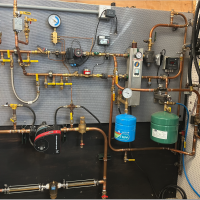How to go from 100lb POL tank to appliances at distance?
Hi there, I have a firepit that is rated for 300k btu (not that it will ever be turned up that high) and a grill that is rated for 90k. I have a HomeFlex 3/4" line running from about 50' away. I want to hook up a 100lb tank to this system. I understand that pressure would be an issue if I have a 2 stage regulator at the tank. I was wondering though, can I use a POL to 3/4 NPT fitting and put a single stage regulator like this one
at the tank lowering psi to 10psi and then have the second stage at each appliance dropping it to 1 or 2 psi then have the appliance regulator? The theroy is that the higher pressure will combat against the longer distance.
Comments
-
You have to do the pressure drop calculations at your working pressures in the various segments. A 100# tank may not be able to supply that much without cooling to a point that the propane does not evaporate.
0 -
You need to know how many BTU that you are actually trying to deliver to answer your question. I've run 150,000 job site heaters off a 100lb tank.
Bob "hot rod" Rohr
trainer for Caleffi NA
Living the hydronic dream0 -
if the fire pit is rated then everything must be sized to accommodate it!
0 -
@Pecmsg The Firepit is a DIY fire ring. Not a pre made firepit bought from a store. It's rated for UP TO 300k btus but I don't plan to run it anywhere near that. Probably more like 150k. The appropriate regulator would be on each appliance.
@hot_rod Both the grill and firepit would run off the tank no problem but my question is really more geared to the length of the run. No one can seem to answer whether it's possible to run a 100lb tank on a 50' line if I keep the pressure high 10psi or so and then drop it again at the appliance.
@mattmia2 I'm using a 100lb tank because I don't want a larger uglier tank in this location. 100lb I can still take and fill up myself. How can I figure out the drops? I would call a propane outfite but doubt they'd help if I'm not using their services. Thus my asking for help from the kind folks here
0 -
People can answer your question its just you need all the info first. You need to know the total connected capacity of the appliances, the set pressure of your supply, fuel type, total equivalent length, and pipe material. From there it is as simple as opening the fuel gas code and finding the appropriate chart for your fuel type/pipe material/pressure, look at the length on the chart closest to your equivalent length but not less than, find the CFH closest to your total connected capacity but not less than, and boom you have your required pipe size. There are concerns with hooking a 100# tank up like this but generally my concerns are when someone is using one to heat their home, since the tank gets unhooked to often the chances of a loose connection and a leak go up dramatically, many horror stories of homes heated with small tanks going up in smoke. For your application I wouldn't be too worried, seems fine but you need the right info to do the job right.
0 -
so then what is your question?
0
Categories
- All Categories
- 87.3K THE MAIN WALL
- 3.2K A-C, Heat Pumps & Refrigeration
- 61 Biomass
- 427 Carbon Monoxide Awareness
- 119 Chimneys & Flues
- 2.1K Domestic Hot Water
- 5.8K Gas Heating
- 115 Geothermal
- 165 Indoor-Air Quality
- 3.7K Oil Heating
- 76 Pipe Deterioration
- 1K Plumbing
- 6.5K Radiant Heating
- 395 Solar
- 15.6K Strictly Steam
- 3.4K Thermostats and Controls
- 56 Water Quality
- 51 Industry Classes
- 50 Job Opportunities
- 18 Recall Announcements

